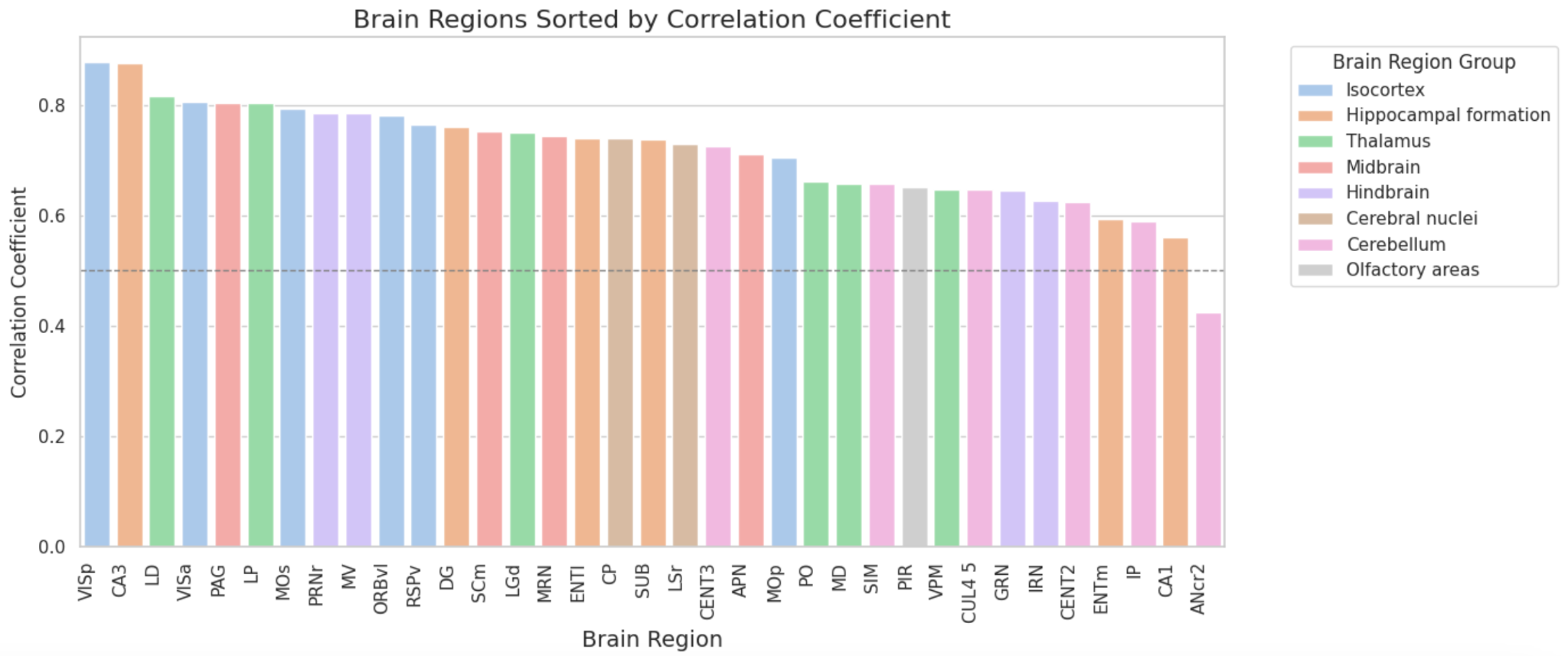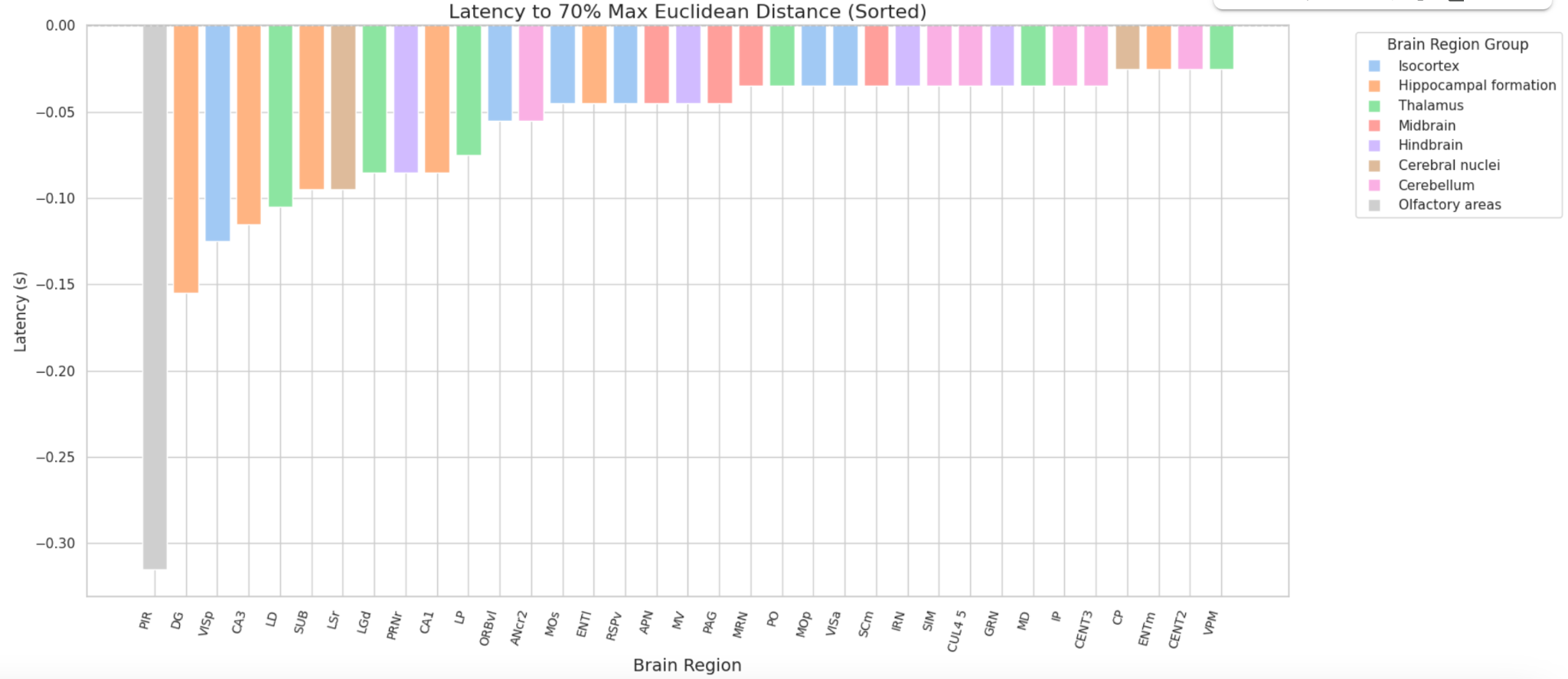Introduction
Understanding how distributed brain regions support decision-making is a central challenge in neuroscience.
In this project, we aim to identify which mouse brain areas encode enough information to predict behavioral choices (left or right) before movement execution.
Data & Materials
- Dataset: International Brain Laboratory (IBL) public electrophysiology recordings
- Subjects: Mice performing a two-alternative forced choice visuomotor discrimination task
- Brain coverage:Recordings from 280+ brain regions, at single-neuron resolution
Data Analysis Methods
The project involved several analysis steps to uncover how brain-wide neural activity predicts decision-making in mice.
My Main Contributions: Choice Representation & Decoding Analysis
-
PCA-based Neural Representation Analysis:
- For each brain region, neural activity was first split by the animal's eventual choice (left vs. right).
- Principal Component Analysis (PCA) was applied to reduce the high-dimensional neural activity to two principal components at each time point, visualizing population dynamics for each choice.
- At each time point, the Euclidean distance between the left and right choice trajectories (in PC1–PC2 space) was computed to quantify divergence in neural representations.
- Analysis focused on brain regions with at least 500 recorded neurons to ensure robust representation.
- For each region, calculated the correlation coefficient between Euclidean distance and time to identify regions where choice representations diverged over the decision period.
- Latency for each region was defined as the time when Euclidean distance reached 70% of its maximum value, indicating how early choice information emerges in that region.
-
Decoding Analysis:
- Extracted neural activity in a pre-movement time window for each brain region.
- Trained a logistic regression classifier for each region to predict the animal's upcoming choice based on neural activity.
- Aggregated decoding accuracy by major brain area for cross-region comparison.
- Visualized decoding accuracy for all regions, highlighting key areas involved in decision prediction.
Other analyses performed by the team include:
-
Firing rate analysis:
Calculated mean firing rates before movement onset, comparing left and right choice conditions across brain regions. -
Functional mapping:
Grouped brain regions by anatomical and cognitive domains (e.g., isocortex, hippocampus, subcortical), linking decoding and representation results to broader brain systems. -
Visualization:
Generated barplots, grouped summaries, and distribution figures for decoding accuracy, firing rates, and representation divergence.
Main Findings
- Isocortex regions (especially frontal and motor areas) show the strongest and most consistent predictive signals for upcoming mouse choices.
- Several subcortical and hippocampal regions (e.g., CA3, CP, ACB) also contribute, but with more variable performance.
- Choice-related neural representations (as measured by PCA divergence) emerge earliest and most robustly in the isocortex and hippocampus.
- The results support a distributed network model for decision-making, but with a central role for the isocortex.



How neural population activity in representative brain regions (VISp, CA3, PIR) diverges between left and right choices before movement.
- Left: Population neural trajectories for left (blue) and right (red) choices, projected onto the first two principal components via PCA.
- Right: Time course of the Euclidean distance between left and right choice trajectories, indicating when and how strongly each region encodes choice information. The red dot marks the latency at which 70% of maximum separation is reached.

Correlation Coefficient by Region:
Brain regions by the correlation coefficient between Euclidean distance (choice separation) and pre-movement time.
Higher coefficients indicate regions where neural representations for left vs. right choices diverge more strongly over time.

Latency to 70% Max Separation:
The latency (in seconds) at which each brain region reaches 70% of its maximum Euclidean distance between choice trajectories.
More negative values indicate earlier emergence of choice-related neural divergence.
This project was developed for the Neuromatch Academy Computational Neuroscience course.